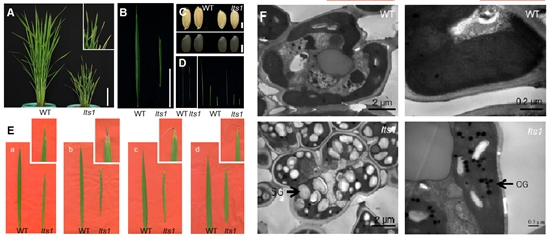分享到
Progress on Molecular Mechanism of Leaf Senescence via NAD pathway in Rice
Premature leaf senescence affects plant growth and yield in rice. Nicotinamide adenine dinucleotide (NAD) plays critical roles in cellular redox reactions and remains at a sufficient level in the cell to prevent cell death. Although numerous factors affecting leaf senescence have been identified, few involving NAD biosynthetic pathways have been identifiedfor plants.
Recently, scientists from China National Rice Research Institute (CNRRI) of Chinese Academy of Agricultural Sciences (CAAS) have acquired progress on molecular mechanism of leaf senescence in rice. In the study, CNRRI scientists characterized a leaf tip senescence 1 (lts1) mutant and LTS1 encoded an Oryza sativa nicotinate phosphoribosyltransferase 1 (OsNaPRT1) in the NAD salvage pathway. A point mutation in OsNaPRT1 leads to dwarfism and the withered leaf tip phenotype, and the lts1 mutant displays early leaf senescence compared to the wild type.

The mutant form of OsNaPRT1 dismantles the NAD salvage pathway and the leaf nicotinate and nicotinamide contents are elevated in lts1, while NAD levels are reduced. Leaf tissue of lts1 exhibited significant DNA fragmentation and H2O2 accumulation, along with up-regulation of genes associated with senescence.
The lts1 mutant also showed reduced expression of SIR2-like genes (OsSRT1 and OsSRT2) which is caused by increased nicotinamide contents. As OsSRTs has been reported to be mainly involved in histone H3K9 deacetylation in rice, the repressed OsSRTs increased acetylation of histone H3K9. Down-regulation of OsSRTs also induced histone H3K9 acetylation of senescence-related genes and activated them. These results suggest that deficiency in the NAD salvage pathway can trigger premature leaf senescence due to transcriptional activation of senescence-related genes.

This work was supported by the National Natural Science Foundation of China (Grants 31461143014, 31521064 and 31501279), the Chinese 973 Program (2013CBA01405), China Postdoctoral Science Foundation (2015M570181) and Shenzhen Scientific and Technological Program (JCYJ20150630165133402).
The research result has been published online on Plant Physiology on April 5th, 2016 (doi: 10.1104/pp.15.01898). More details are available on the links bellow:
http://www.plantphysiol.org/content/early/2016/04/05/pp.15.01898.abstract
Recently, scientists from China National Rice Research Institute (CNRRI) of Chinese Academy of Agricultural Sciences (CAAS) have acquired progress on molecular mechanism of leaf senescence in rice. In the study, CNRRI scientists characterized a leaf tip senescence 1 (lts1) mutant and LTS1 encoded an Oryza sativa nicotinate phosphoribosyltransferase 1 (OsNaPRT1) in the NAD salvage pathway. A point mutation in OsNaPRT1 leads to dwarfism and the withered leaf tip phenotype, and the lts1 mutant displays early leaf senescence compared to the wild type.

The mutant form of OsNaPRT1 dismantles the NAD salvage pathway and the leaf nicotinate and nicotinamide contents are elevated in lts1, while NAD levels are reduced. Leaf tissue of lts1 exhibited significant DNA fragmentation and H2O2 accumulation, along with up-regulation of genes associated with senescence.
The lts1 mutant also showed reduced expression of SIR2-like genes (OsSRT1 and OsSRT2) which is caused by increased nicotinamide contents. As OsSRTs has been reported to be mainly involved in histone H3K9 deacetylation in rice, the repressed OsSRTs increased acetylation of histone H3K9. Down-regulation of OsSRTs also induced histone H3K9 acetylation of senescence-related genes and activated them. These results suggest that deficiency in the NAD salvage pathway can trigger premature leaf senescence due to transcriptional activation of senescence-related genes.

This work was supported by the National Natural Science Foundation of China (Grants 31461143014, 31521064 and 31501279), the Chinese 973 Program (2013CBA01405), China Postdoctoral Science Foundation (2015M570181) and Shenzhen Scientific and Technological Program (JCYJ20150630165133402).
The research result has been published online on Plant Physiology on April 5th, 2016 (doi: 10.1104/pp.15.01898). More details are available on the links bellow:
http://www.plantphysiol.org/content/early/2016/04/05/pp.15.01898.abstract
By Yuan Yiqing
yuanyiqing@caas.cn
yuanyiqing@caas.cn
Latest News
-
 Apr 18, 2024Opening Ceremony of the Training Workshop on Wheat Head Scab Resistance Breeding and Pest Control in Africa Held in CAAS
Apr 18, 2024Opening Ceremony of the Training Workshop on Wheat Head Scab Resistance Breeding and Pest Control in Africa Held in CAAS -
 Apr 03, 2024IPPCAAS Co-organized the Training Workshop on Management and Application of Biopesticides in Nepal
Apr 03, 2024IPPCAAS Co-organized the Training Workshop on Management and Application of Biopesticides in Nepal -
 Mar 28, 2024Delegation from the School of Agriculture and Food Science of University College Dublin, Ireland Visit to IAS, CAAS
Mar 28, 2024Delegation from the School of Agriculture and Food Science of University College Dublin, Ireland Visit to IAS, CAAS -
 Mar 25, 2024Director of World Food Prize Foundation visited GSCAAS
Mar 25, 2024Director of World Food Prize Foundation visited GSCAAS -
 Mar 20, 2024Institute of Crop Sciences (ICS) and Syngenta Group Global Seeds Advance Collaborative Research in the Seed Industry
Mar 20, 2024Institute of Crop Sciences (ICS) and Syngenta Group Global Seeds Advance Collaborative Research in the Seed Industry
